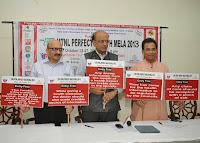 21st October 2013:
21st October 2013:
Addressing a
press conference, Padma Shri and Dr. B C Roy National Awardee, Dr. K K Aggarwal, President Heart Care
Foundation of India said that Health Mela concept is nothing but passing
on credible health information to the people who are gathered by attracting
them using traditional folk or modern infotainment modules.
The press conference was organized
to earmark the 0th MTNL Perfect Health Mela to open on 23rd October.
The Mela is
being organized by the Heart Care Foundation of India at Constitution Club of
India, New Delhi from 23rd to
27th October, 2013 in association with the Departments of Central and
Delhi Government, Central Bank of India , LIC, Coca Cola, GAIL and
various hospitals and NGOs.
The press was
co-addressed by Mr. Ashok Chakradhar,
noted Poet and Dr. Praveen Chandra, Chairman,
Interventional Cardiology at Medanta - The Medicity, Gurgaon.
 The experts
said that today when
The experts
said that today when
Any wrong
information from the mouth of a health expert can create panic in the
society. Giving examples the experts said that Swine Flu panic ended
up with increased number of patients with rheumatic fever and dengue epidemic panic
has ended up with unnecessary platelet transfusion.
The expert said that time has come
for the health information to be regulated by the councils.
Dr. Aggarwal
said that under Section 7.11 of Code of Medical Ethics by Medical Council of
India, a doctor should not contribute to the lay press articles and
give interviews regarding diseases and treatments which may have the effect of
advertising himself or soliciting practices; but is open to write to the lay
press under his own name on matters of public health, hygienic living or to
deliver public lectures, give talks on the radio/TV/internet chat for the same
purpose and send announcement of the same to lay press.
Therefore, any
exaggeration of a disease or creating panic in the society, soliciting patients
amounts to professional misconduct.
1.
The health information should be fact-based, field tested and should not create
any panic or fear in the society.
2. The principles of hit
the iron when it is hot and involving the people who counts should be adhered
to.
3. While giving a
health statement, the doctor should also quote credible source of information.
 4.
As of today, the credible sources of studies are Meta-Analysis, Randomized
controlled studies and Reviews published in credible
journals. Individual case reports or non-randomized controls may not
be accepted as the recommendations.
4.
As of today, the credible sources of studies are Meta-Analysis, Randomized
controlled studies and Reviews published in credible
journals. Individual case reports or non-randomized controls may not
be accepted as the recommendations.
5. Any claim of cure
should be accepted with a pinch of salt.
6.
The Medical Council of India
does not allow doctors to endorse any drug or product publicly. The council
expects that any study conducted by a doctor on the efficacy or otherwise of a
product shall be first presented to and/or through appropriate scientific
bodies or published in a proper scientific journal in a proper way.
7. Health information
should be evidence-based medicine.
About HCFI : The only National Not for
profit NGO, on whose mega community health education events, Govt. of India has
released two National Commemorative stamps and one cancellation stamp, and who
has conducted one to one training on” Hands only CPR” of 63425 people since 1st
November 2012.
The CPR 10 Mantra is – “Within 10
minutes of death, earlier the better; at least for the next 10 minutes, longer
the better; compress the centre of the chest of the dead person continuously
and effectively with a speed of 10x10 i.e. 100 per minute.”




I like your post. This post really awesome and very helpful to me. Please keep posting good contents. Thank you.
ReplyDeletekimera